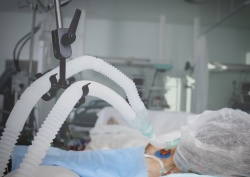Anxiety management
Self-administered sedatives can help the critically ill
New research takes a novel approach to traditional, clinician-only sedative delivery, finding that select critically ill patients can safely self-administer sedatives to manage their anxiety during mechanical ventilation.

Patients in intensive care units (ICUs) are often lightly sedated to promote their comfort with mechanical ventilator breaths and to reduce anxiety. Clinicians use subjective assessment and observation of the patient to administer medications, and the resulting sedative delivery may be inconsistent across providers and not congruent with individual patient needs. “How best to manage the many symptoms experienced by patients undergoing mechanical ventilation without contributing to adverse ICU-acquired conditions remains a daunting challenge for clinicians,” Linda Chlan, RN, PhD, professor of nursing and associate dean for nursing research at Mayo Clinic, Rochester, Minnesota and leader of the study said. “Addressing these complex issues requires innovative approaches and challenging the usual way of managing critically ill patients. By appropriately empowering patients to self-manage their symptoms, we can help meet their highly individualized needs for sedative therapy to promote comfort.”
37 participants
The study builds upon prior research that found patients receiving mechanical ventilation were willing, able and satisfied with their ability to self-administer sedative medication to manage their anxiety. During the pilot trial in three ICUs in Minnesota, 17 intubated patients were randomly assigned to self-administer dexmedetomidine, which provides light sedation, and 20 patients were allocated to receive usual care, continuing their current sedative regimen. Only patients receiving mechanical ventilation who were willing and able to self-manage sedative therapy were eligible for the study. Patients who self-administered dexmedetomidine were instructed to depress the push button when they felt anxious or if they desired medication for relaxation. They were allowed up to three self-administered boluses of the sedative therapy per hour, with a 20-minute lockout. Bedside nurses also adjusted the basal infusion rate, according to the patients’ bolus attempts in the preceding two hours.
Patients satisfied with self-administration
Overall, findings indicate that dexmedetomidine is safe, using pre-defined criteria, for a select sample of patients during the later, more stable part of mechanical ventilation. Changes in heart rate and mild hypotension during the infusion were comparable to those noted with clinician-administered sedatives. No self-extubations occurred in patients randomized to the dexmedetomidine group. A follow-up survey also found that a majority of patients in the experimental group were satisfied with their ability to self-administer sedative therapy to control anxiety and achieve relaxation. Their ability to manage anxiety was comparable to that of patients who received clinician-administered medication. Interestingly, no patients in the dexmedetomidine group experienced delirium after enrollment, whereas four patients in the usual care group did.
Source: American Association of Critical-Care Nurses (AACN)
05.07.2017









